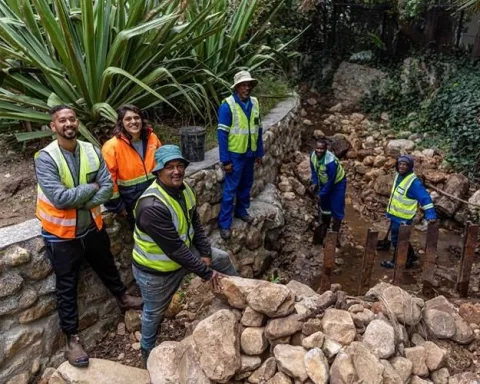Kensington in Cape Town is undergoing a major infrastructure transformation, moving from overhead electricity lines to an underground system. This project involves replacing over 5,500 metres of overhead electricity conductors and 42 transmission poles with 5,315 metres of underground cabling. The project is set to improve the reliability of infrastructure, area aesthetics, and safety. It is projected to be completed by April 2024 and is part of the City of Cape Town’s efforts to mitigate chronic load-shedding and rampant vandalism. The benefits of transitioning to an underground power infrastructure are manifold, including enhanced reliability, improved safety, and boosted visual appeal.
What is the Infrastructure Renaissance in Kensington?
Kensington in Cape Town is undergoing a major infrastructure transformation, moving from overhead electricity lines to an underground system. This project involves replacing over 5,500 metres of overhead electricity conductors and 42 transmission poles with 5,315 metres of underground cabling. The project is set to improve the reliability of infrastructure, area aesthetics, and safety. It is projected to be completed by April 2024 and is part of the City of Cape Town’s efforts to mitigate chronic load-shedding and rampant vandalism.
Kensington, a charming suburb in Cape Town, South Africa, is currently experiencing a phenomenal shift set to reshape its power infrastructure significantly. The City is spearheading a series of substantial interventions to mitigate chronic load-shedding and rampant vandalism, beginning with a R3.8 million project. This ambitious endeavor aims to transition the existing overhead electricity network to a comprehensive underground system.
A Monumental Transformation in Progress
This colossal project, targeting completion by April 2024, involves the replacement of over 5,500 metres of overhead electricity conductors and 42 transmission poles with an astonishing 5,315 metres of underground cabling. A recent visit to the site by the City’s Mayoral Committee Member for Energy, Councillor Beverley van Reenen, and her team showcased just how monumental this transformation is shaping up to be.
Councillor Van Reenen expressed her optimism about the Kensington underground cable project citing it as a significant stride in mitigating vandalism risks. She also praised the project’s progression, emphasizing on the anticipated improvements in electricity efficiency. She expressed gratitude to the local inhabitants for their ongoing patience and active cooperation during this transition.
The Benefits of Underground Cabling
The switch from overhead to underground cabling is more than just a practical initiative; it brings along multiple benefits for the community. Although implementing such a significant change instantly across all areas is not feasible, the City prioritizes regions where this shift is most practical and impactful.
The Kensington project, upon completion, is projected to deliver paramount improvements in the reliability of infrastructure, area aesthetics, and safety. This initiative showcases the City’s continued pledge to invest in communities and deliver top-notch service across all city jurisdictions. The Energy Directorate’s commendable utilization of 96.86% of the R1 billion Capital Budget Spend in the previous financial year is proof of their unwavering commitment to effective service delivery.
The Improved Infrastructure and its Advantages
The benefits of transitioning to an underground power infrastructure are manifold. The primary advantage is the enhanced reliability of the entire system. The newly designed infrastructure is engineered to withstand weather-related faults such as storm damage and the impacts of falling trees.
From an aesthetic perspective, the absence of poles and overhead power lines will significantly enhance Kensington’s visual appeal. This visual makeover is synergistic with the enhanced safety the new system provides. The likelihood of electrical accidents stemming from people, vehicles, and animals interacting with power lines will be substantially mitigated. Also, the underground nature of the power lines could potentially lower the risk of vandalism.
Ensuring the Longevity of the New System
The shift toward an underground electricity network is not merely a sign of progress, but it is a strategic measure to safeguard our community infrastructure. Every community member has a role in this transition, and by reporting any suspicious activities near the electricity infrastructure to the City’s law enforcement agencies or the Fraud Hotline, we can maintain the security and durability of our new system.
The South African Police Service (SAPS) remains the primary authority in preventing crime. Thus, any concerns or reports related to the infrastructure should be communicated to them or the City’s Fraud Hotline at 0800 1100 77.
In summation, the Kensington underground electricity cable project is a monumental leap toward establishing a safer, more efficient, and visually appealing community. It stands as a fine example of how urban regions can utilize modern technology to upgrade their infrastructure, thereby enhancing the quality of life for their residents.
1. What is the Infrastructure Renaissance in Kensington?
Kensington in Cape Town is undergoing a major infrastructure transformation, moving from overhead electricity lines to an underground system. This project involves replacing over 5,500 metres of overhead electricity conductors and 42 transmission poles with 5,315 metres of underground cabling.
2. What are the benefits of transitioning to an underground power infrastructure?
The benefits of transitioning to an underground power infrastructure are manifold, including enhanced reliability, improved safety, and boosted visual appeal. The new infrastructure is engineered to withstand weather-related faults such as storm damage and the impacts of falling trees. The absence of poles and overhead power lines will significantly enhance the area’s visual appeal, while the likelihood of electrical accidents stemming from people, vehicles, and animals interacting with power lines will be substantially mitigated.
3. When is the project projected to be completed?
The project is set to be completed by April 2024.
4. Why is the City of Cape Town transitioning to an underground power infrastructure?
The City of Cape Town is transitioning to an underground power infrastructure as part of its efforts to mitigate chronic load-shedding and rampant vandalism.
5. What is the cost of the project?
The cost of the project is R3.8 million.
6. How can community members contribute to the safety and durability of the new system?
Community members can contribute to the safety and durability of the new system by reporting any suspicious activities near the electricity infrastructure to the City’s law enforcement agencies or the Fraud Hotline at 0800 1100 77.












